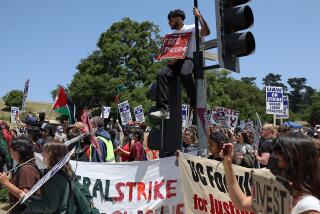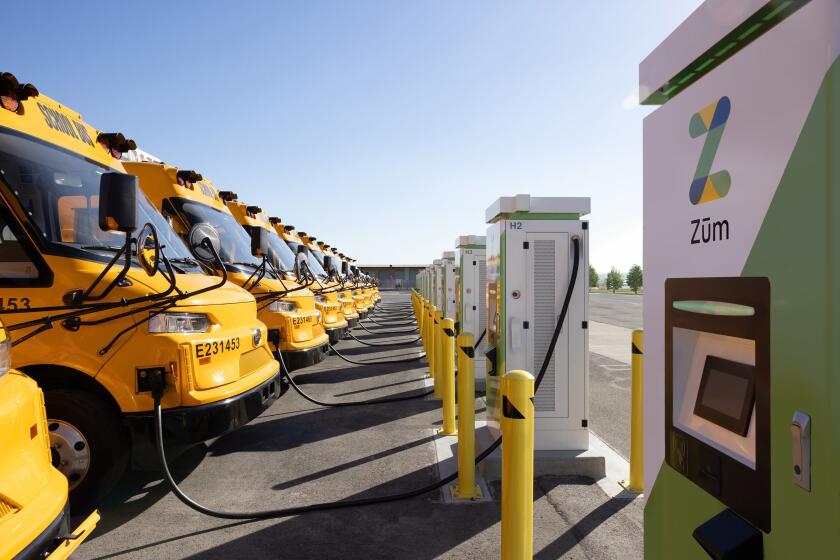Tax Cuts for Utilities Hurt School Funding
You don’t have to wait for the lights to go off to understand just how much California depends on utility generators.
In San Luis Obispo, teachers are being laid off and, for the first time, students will have to pay to ride the bus because of a budget crunch brought on by energy deregulation and tax cuts to utilities.
While these reductions are being felt statewide, they are hitting particularly hard in San Luis Obispo, which has long been unusually dependent on taxes paid by utilities.
“In terms of pure dollars, this is a big impact on us,” said Roy Livingston, an assistant superintendent in the 8,200-student San Luis Coastal district. “Some folks are not real happy.”
One of them is Jeff Decker, the chief negotiator for the local teachers association. “There’s a lot of frustration and a lot of anger,” he said. “The district got program-happy. Now when things get tough, the programs have to go.”
On Feb. 20, citizen trustees for the county’s second-largest school district responded to the decline in utility tax payments by cutting $3.6 million in spending to balance its $52-million budget. The cuts will force layoffs of 32 teachers and three administrators. Nursing, custodial and secretarial services are being slashed. Student athletes may be required to pay their way to games, some of which are held as far as two hours from campus.
The cuts are surprising, coming when other school districts are adding classrooms and boosting teachers’ pay--15% in Los Angeles alone. The red ink is also an unaccustomed shock to the San Luis district, which for years luxuriated in a budget accommodating enough to fund one-on-one reading instruction for lagging first-graders.
While most schools in the state are crowded, the largest high school in San Luis has 1,200 students. Instead of the standard six-period day, students attend seven classes in high school. Foreign language choices include American sign language and Latin.
“They were really doing well,” said Gere Sibbach, the county’s auditor.
That was before deregulation came along and an obscure state agency, the Board of Equalization, cut utility property taxes.
Like homeowners, a utility must pay taxes on the land it owns, and over which its power lines run. The total value of that property in the state last year was $63 billion. As large as that is, it’s $6 billion less than just two years earlier.
Since the tax rate is 1.1% of the total, that means the utilities paid $68 million less in property taxes in 2000 than in 1998. That in turn meant $36 million less for schools. The shortfall in poorer school districts is made up by the state, but the state’s 75 more affluent districts had to absorb the loss.
The effect is especially large in the San Luis district, whose boundaries include the giant Diablo Canyon nuclear power plant, as well as the web of power transmission lines carrying Diablo’s energy outward to the rest of the state.
Diablo Canyon has accounted for a third of the property taxes supporting the district, Sibbach said. “We’re the hardest hit,” Livingston said.
But San Luis Coastal is not alone. Assessor Dick Frank said 35% of the county’s entire property tax roll was utility money at one time.
“We’ve been weaning ourselves off because of necessity,” Sibbach said.
The typical homeowner struggling to keep up with taxes is tempted to ask: How can my property taxes go up every year, while PG&E;’s and Southern California Edison’s are going down? The answer lies in how the Board of Equalization values utility property.
Deregulation led utilities to sell off dozens of power plants in the state, which reduced the value of the utilities, said Dick Johnson, an official with the Board of Equalization. While the owners of 22 of these plants are now taxed by local county assessors, that money doesn’t make up for the loss in tax money elsewhere, officials said. Frank said it would probably add up to only $1 billion of the $6 billion loss.
The utilities also saved money when a 1992 settlement of a lawsuit over utility property valuations expired in 1999. Finally, although the cost of energy is going up, power plants such as Diablo Canyon that make electricity are getting older, which means their value is lower.
“The utility industry has been lobbying to have its property taxes reduced, and they’ve been quite successful,” Livingston said.
The Board of Equalization’s five elected members have been divided over how to value utility property. “I don’t like to vote for tax breaks if they’re not passed on to customers,” said Johan Klehs, who represents the Northern California district. He voted against many utility tax changes, and says that, if he had not done that, people in San Luis Obispo would have lost even more money.
“Any time the Board of Equalization votes to cut utility property taxes, the people who lose the most are education, police and fire,” Klehs said.
In particular, he called the terms of the lawsuit settlement “a fair method of taxation that the utilities had no interest in continuing.”
Jon Tremayne, a spokesman for PG&E;, said the reduced tax assessments are “absolutely” fair. With deregulation, “we’re worth less than we were before.”
If parents and teachers in San Luis Coastal are unhappy now, things could get worse if Gov. Gray Davis goes through with a plan to take over the power transmission lines owned by the utilities. That could further slash property taxes paid by PG&E.;
Then there’s the long-term prospect of the state’s taking over the utilities. “We’re very concerned,” said Frank. “It would be very devastating to our county.”
More to Read
Start your day right
Sign up for Essential California for news, features and recommendations from the L.A. Times and beyond in your inbox six days a week.
You may occasionally receive promotional content from the Los Angeles Times.






